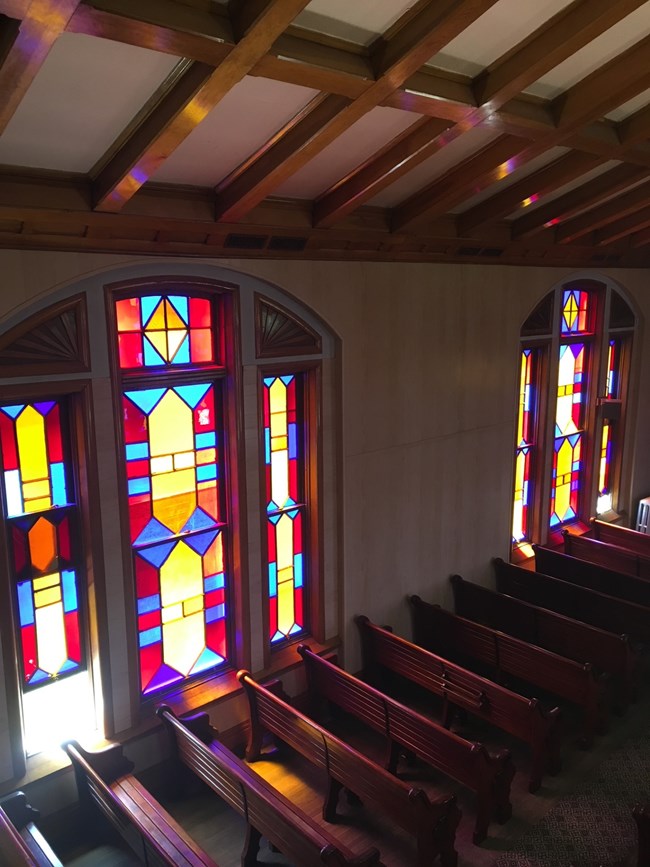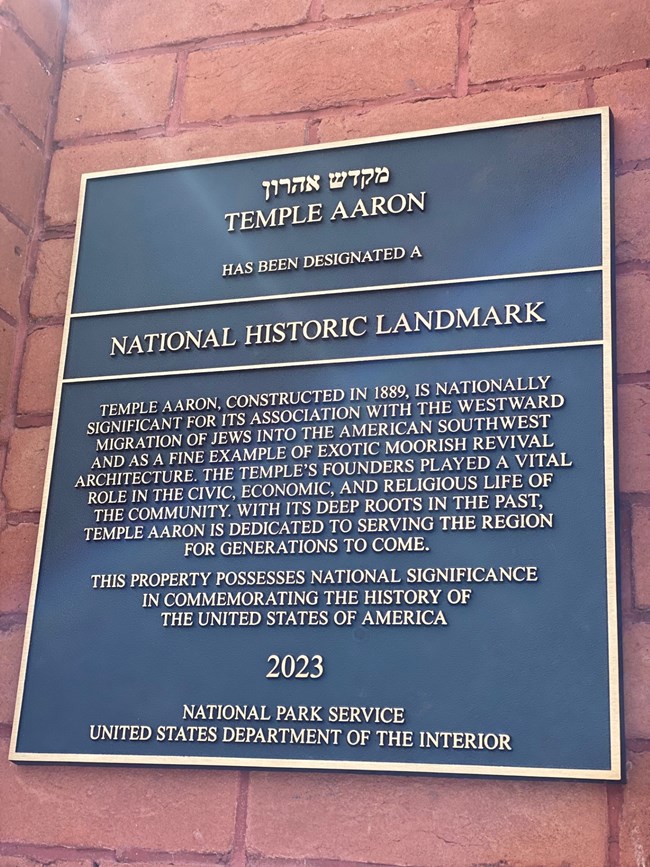Part of a series of articles titled National Register and National Historic Landmarks Celebrate Jewish Heritage Month.
Article
Trinidad's Temple Aaron

Astrid Liverman/NPS
Temple Aaron was listed in the National Register of Historic Places in 1973 as part of the Corazon de Trinidad Historic District. However, the nomination did not address Temple Aaron’s individual significance, which is the focus of the 2023 National Historic Landmark nomination.

Astrid Liverman/NPS
Early Days of Trinidad
A true “frontier town,” Trinidad grew in response to trade along the Santa Fe Trail Mountain Branch. The town was previously part of the Las Animas Mexican land grant, a heritage that can be seen in its adobe plazas and commercial streets. Coal, coke, iron, brick, stone quarrying, smelting industries, and cattle ranching quickly followed, all supported by the development of railroads. In 1867, Jewish merchant Abraham Jacobs extended the Denver-Pueblo stage route to Trinidad, and Richard Lacey “Uncle Dick” Wootton created the Raton Pass Toll Gate, spurring Trinidad’s development.
By the late 1860s, Trinidad was home to approximately 1,200 people of diverse ethnic and geographic origins. Between 1860 and 1871, approximately eight young Jewish men from Hanover, Bavaria, Bohemia, and Alsace-Lorraine settled in Trinidad. Trinidad’s Jewish settlers benefited from religious tolerance and had the foresight and business acumen to capitalize on the need for suppliers and investment, emerging as pillars in the community. Temple Aaron’s construction in 1889 demonstrated the acceptance, integration, and economic and civic leadership of Trinidad’s Jews.
Temple Aaron’s founders played important leadership roles in the civic and social life of the region, in addition to its spiritual or religious life. Maurice Wise is believed to be the first permanent Jewish resident of Trinidad, arriving in 1867 and opening a small general store on Main Street. Merchant Samuel Jaffa was elected as the first mayor in 1876. Solomon Jaffa served as city alderman. Together, the Jaffa brothers constructed the opera house, one of Trinidad’s preeminent cultural institutions. The Jaffas and other temple founders also held leadership roles in a variety of fraternal organizations.

Astrid Liverman/NPS
Constructing Temple Aaron
Congregation Aaron was formed in July 1883 at the home of Sol Jaffa, drawing congregants over the next several years from Las Vegas, Elizabethtown, and Raton, New Mexico, as well as Walsenburg, Colorado, to worship. By 1887, the congregation began planning for construction of its own permanent building.Renowned architectural firm Bulger & Rapp designed Temple Aaron in the exotic Moorish Revival style, which at that time was an extremely popular style among Reform Jewish congregations. It communicated that their modern practices and new traditions were connected to an ancient past originating in the Middle East. Constructed on its dramatically sloped site on gray sandstone, the red brick synagogue was designed to visually command its corner lot. Drawing eclectic components from numerous revival styles, Temple Aaron boldly announced its distinctiveness with an onion dome-topped tower, small minarets, pointed-arch openings, and brightly colored stained glass.
The cornerstone was laid by architect Isaac Hamilton Rapp in a public ceremony on June 18, 1889, with Congregation Aaron’s new rabbi, Leopold Freudenthal, delivering a powerful address. Born in Germany in 1848, Freudenthal had studied at Heidelberg University, where he earned his doctorate before emigrating to the United States. Unusually, Freudenthal was not ordained as a rabbi in Europe, but may have attended the Hebrew Union College in Cincinnati, Ohio, in the Reform tradition. It was while serving as the chaplain of the Iowa State Legislature that Freudenthal was hired to serve Congregation Aaron, the membership of which was fifty-four families at that time. Services were conducted in Hebrew, German, and English. Instrumental in bringing the congregation more fully into the Reform tradition, Freudenthal remained in leadership and service at Temple Aaron until his death in 1916.
Truly comparable properties west of the Mississippi River are difficult to find, as very few synagogues dating from this time period remain in use today by Jewish congregations. Rapp (1854-1933) went on to a regional prominence, designing buildings in Trinidad and the Southwest, particularly in New Mexico, where he is credited as the originator of the “Santa Fe style.”
In the mid-to-late twentieth century, descendants of the original founders and other families like the Gottliebs, Sanders, and the late Kathryn and Leon Rubin, helped sustain the synagogue’s operations and presence in the community. More than 130 years after Temple Aaron’s construction in 1889 and more than 135 years after its first minyan gathered, this small congregation sustains the ongoing story of the Jewish people in the American West and continues to serve congregants from throughout Colorado’s Front Range and northern New Mexico.
This summary is drawn from the National Historic Landmark nomination authored by Rachel Leibowitz, PhD. Temple Aaron was designated an NHL on December 11, 2023.
Last updated: May 1, 2024
